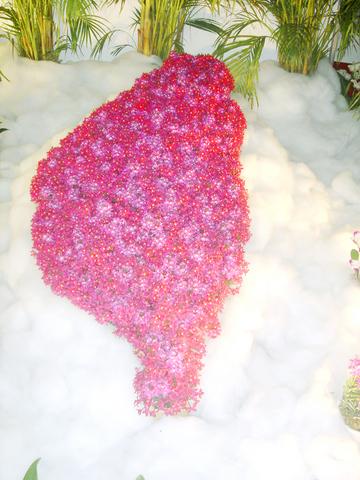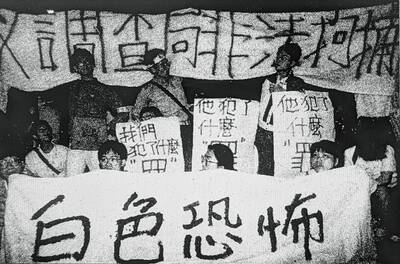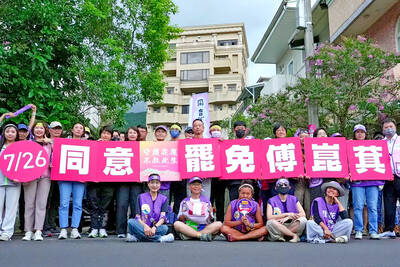Orchid cultivation can be difficult. From pollination to bloom, the growth process generally takes two-and-a-half years. Yet there are many orchid enthusiasts and tradition deems the long wait to be worth it. The oval-shaped phalaenopsis amabilis -- or moth orchid (
Orchids nowadays are of many hues and patterns and some of the favorites are white, yellow and orange-to-dark brown. Others have striped patterns or large and small dots. The most popular orchid in Taiwan, however, is the native phalaenopsis amabilis var Formosana (
The late Dr Chiba Masaaki (

It grows in remote areas of the country, in counties south of the Tropic of Cancer, according to Professor Shen Rong-show (
Taking advantage of the favorable natural orchid-growing environment in Chiayi, Professor Shen and four of his colleagues are setting up and maintaining greenhouses for research purposes. Every greenhouse is constantly monitored and controlled by computers that keep an electronic eye on lighting intensity, air moisture, ventilation, temperatures (between 24?C and 25?C during the day and between 18?C and 19?C at night).
Assisted by a group of dedicated graduate students, gorgeous new prize-winning orchids are produced by hybridization. The university's latest creation is derived from a genus of orchids called the violocea. It is currently called HT107 and does not have an official name yet, but it has a subtle and delightful fragrance. Among the world's orchid species, only two kinds are known to yield a fragrance and HT107 is one of them, said Professor Lily Chien (

The HT107 is currently the shining star at the International Orchid Show, running until April 10 in Hobi (
At least one local business group has shown interest in reproducing this exquisite orchid scent for commercial purposes.
Chiayi University is the only higher-education establishment to conduct academic research on orchid breeding, propagation, preservation and the stocking of endemic orchid species worldwide. It is something of a brain trust in the worldwide orchid industry.
Another one of its achievements is a fruitful cooperation with I-Hsin Biotec Inc (
I-Hsin is one of the biggest orchid companies in Taiwan and is run by the Jian family, whose members are mostly graduates from Chiayi university's department of horticulture. The company has stolen the show at the Tainan International Orchid Show with a range of high-tech products that produce large and multi-flowering types of white- and red-flowered phalaenopsis. The company is also well-known for producing high-quality dendrobiums (
Traditionally, Japan and the US have been Taiwan's two major orchid-export markets, netting NT$391 million and NT$221 million from these two countries, respectively, last year.
Chiayi University has also set its sights on capturing a greater share of the European orchid market.
Since Europeans by-and-large buy small-sized orchids, Professor Shen and his colleagues are now trying to breed miniature species with smaller blossoms that bear as many flowers as possible on each plant. This should challenge the Dutch growers in Europe.
Good orchids can bear flowers for as long as three months, but nowadays they do not just bloom in spring. Simple regulation techniques in greenhouses can ensure that orchids bloom all year long.
There seems to be no limit to the innovation of the local orchid industry, but it was the Taiwan Sugar Company that initially started orchid research in 1988 at its Wushulin (
Tainan County Commissioner Su Huan-chih (
However, intensifying competition from rival countries such as The Netherlands, Costa Rica and China is worrying local growers. For instance, orchid farmers in China (ironically, many of them are from Taiwan) have been applying low-cost tactics to penetrate the global market for years. Dutch orchid traders can take advantage of their strong international sales networks to push their products. In fact, the commercial orchid battle between Taiwan and Holland has become so intense that neither of them will trade new species any more.
Su predicted all this would happen and four years ago helped win central government support for the industry with a NT$2.06 billion investment in a large-scale industrial park, the Taiwan Orchid Plantation (TOP), which covers an area of 200 hectares in Hobi.
The park includes a permanent exposition hall and trading office complex equipped with greenhouses ranging in size from 1,150m2 to 3,471m2. There are also genetic-modification laboratories, and the academic research center at National Chiayi University.
The TOP project -- expected to be completed in 2008 -- is going smoothly with more than 40 orchid companies committed to move into the park. The International Orchid Show held inside the park this year intends to tell the world that Taiwanese orchid farmers are organizing themselves into large-scale international enterprises, with massive amounts of investment from the government.
Su said TOP is primarily designed to impress international buyers by offering the opportunity for face-to-face contact with Taiwanese orchid farmers so that the buyers can have a close look at the producers' facilities before they conclude business deals.
It is clear both the government and entrepreneurs have high hopes for the orchid industry and intend it to become another commercial success story like the IT industry. But instead of making motherboards the orchid industry produces cash-rich crops in an environmentally friendly way.

From the last quarter of 2001, research shows that real housing prices nearly tripled (before a 2012 law to enforce housing price registration, researchers tracked a few large real estate firms to estimate housing price behavior). Incomes have not kept pace, though this has not yet led to defaults. Instead, an increasing chunk of household income goes to mortgage payments. This suggests that even if incomes grow, the mortgage squeeze will still make voters feel like their paychecks won’t stretch to cover expenses. The housing price rises in the last two decades are now driving higher rents. The rental market

July 21 to July 27 If the “Taiwan Independence Association” (TIA) incident had happened four years earlier, it probably wouldn’t have caused much of an uproar. But the arrest of four young suspected independence activists in the early hours of May 9, 1991, sparked outrage, with many denouncing it as a return to the White Terror — a time when anyone could be detained for suspected seditious activity. Not only had martial law been lifted in 1987, just days earlier on May 1, the government had abolished the Temporary Provisions Effective During the Period of National Mobilization for Suppression of the Communist

Hualien lawmaker Fu Kun-chi (傅?萁) is the prime target of the recall campaigns. They want to bring him and everything he represents crashing down. This is an existential test for Fu and a critical symbolic test for the campaigners. It is also a crucial test for both the Chinese Nationalist Party (KMT) and a personal one for party Chairman Eric Chu (朱立倫). Why is Fu such a lightning rod? LOCAL LORD At the dawn of the 2020s, Fu, running as an independent candidate, beat incumbent Democratic Progressive Party (DPP) lawmaker Hsiao Bi-khim (蕭美琴) and a KMT candidate to return to the legislature representing

When life gives you trees, make paper. That was one of the first thoughts to cross my mind as I explored what’s now called Chung Hsing Cultural and Creative Park (中興文化創意園區, CHCCP) in Yilan County’s Wujie Township (五結). Northeast Taiwan boasts an abundance of forest resources. Yilan County is home to both Taipingshan National Forest Recreation Area (太平山國家森林遊樂區) — by far the largest reserve of its kind in the country — and Makauy Ecological Park (馬告生態園區, see “Towering trees and a tranquil lake” in the May 13, 2022 edition of this newspaper). So it was inevitable that industrial-scale paper making would